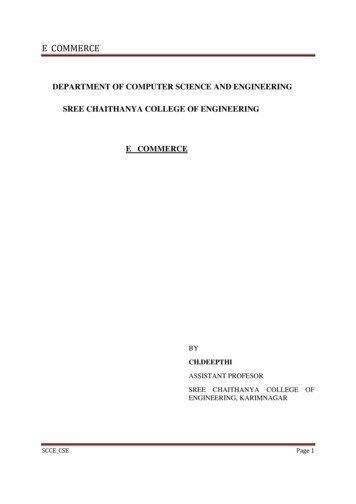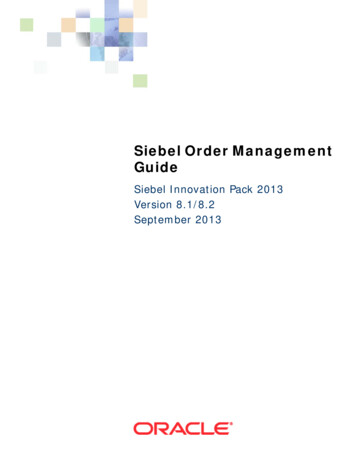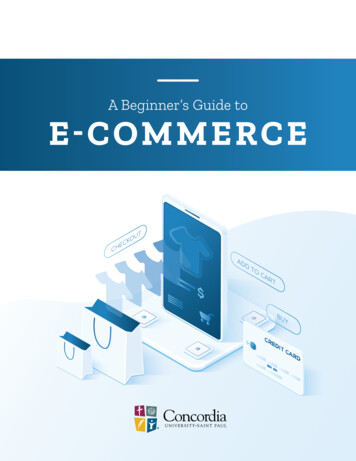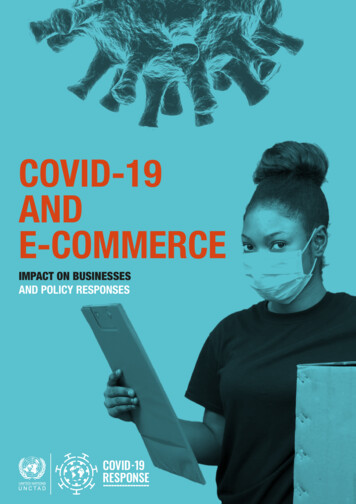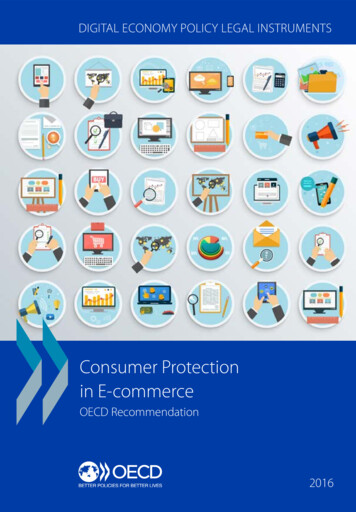
Transcription
DIGITAL ECONOMY POLICY LEGAL INSTRUMENTSConsumer Protectionin E-commerceOECD Recommendation2016 OECD 2015
Consumer Protectionin E-commerceOECD Recommendation
DISCLAIMERThis document and any map included herein are without prejudice to the status of orsovereignty over any territory, to the delimitation of international frontiers and boundariesand to the name of any territory, city or area.Please cite this publication as:OECD (2016), Consumer Protection in E-commerce: OECD Recommendation, OECDPublishing, Paris, nda to OECD publications may be found on line at:www.oecd.org/publishing/corrigenda. OECD 2016You can copy, download or print OECD content for your own use, and you can includeexcerpts from OECD publications, databases and multimedia products in your owndocuments, presentations, blogs, websites and teaching materials, provided that suitableacknowledgment of the source and copyright owner is given. All requests for public orcommercial use and translation rights should be submitted to rights@oecd.org. Requestsfor permission to photocopy portions of this material for public or commercial use shall beaddressed directly to the Copyright Clearance Center (CCC) at info@copyright.com or theCentre français d’exploitation du droit de copie (CFC) at contact@cfcopies.com.
FOREWORD . 3ForewordE-commerce has evolved dramatically since 1999, when the OECD Counciladopted the first international instrument for Consumer Protection in theContext of Electronic Commerce (“1999 Recommendation”). On 24 March 2016,the OECD Council revised this instrument and the Recommendation of theCouncil on Consumer Protection in E-commerce (“the revised Recommendation”)now addresses new and emerging trends and challenges faced by consumers intoday’s dynamic e-commerce marketplace.As called for in the 1998 OECD Ministerial Conference on The Borderless World:Realising the Potential of Global Electronic Commerce, the 1999 Recommendationset forth the core characteristics of consumer protection for electroniccommerce: fair and transparent business and advertising practices, informationabout businesses, goods and services, transactions, as well as adequate disputeresolution and redress mechanisms, payment protection, privacy, and education.Responding again to the invitation of Ministers at the 2008 Ministerial on theFuture of the Internet Economy, the OECD undertook a review of the 1999Recommendation to consider how to further encourage consumers to embracethe opportunities of e-commerce. Beginning with a conference held in 2009 inWashington, D.C., on Empowering E-Consumers: Strengthening Consumer Protection inthe Internet Economy, the OECD Committee on Consumer Policy (CCP) researchedand analysed trends and policy challenges arising in mobile and onlinepayments, the purchase of intangible digital content products, and participativee-commerce.This work outlined the many benefits that e-commerce had brought over adecade to consumers, including wider choices at competitive prices, as wellas easy-to-use and more secure payment options. The work however alsopointed to the higher complexity of the online environment and related risksfor consumers. It showed that, for example, consumers’ understanding of theirrights and obligations was often challenged when they make purchases throughnon-traditional payment mechanisms, such as mobile phone bills or pre-paidcards, or when they acquire digital content products, such as apps or e-books. OECD 2016
4 . CONSUMER PROTECTION IN E-COMMERCEThe OECD Consumer Policy Toolkit further highlighted that when consumers usemobile devices for e-commerce in an “on the go” context, their tendency to takedecisions based on heuristic techniques is exacerbated. Unauthorised charges,misleading and fraudulent commercial practices also remain problematic.Following its thorough review, in 2014, the Committee agreed to revise the1999 Recommendation to address the challenges identified and achieveeffective consumer protection while stimulating innovation and competitionin the market. Key new developments in e-commerce addressed by the revisedRecommendation include: Non-monetary transactions. Consumers increasingly acquire “free” goodsand services in exchange for their personal data and these transactions arenow explicitly included in the scope of the Recommendation. Governmentsand stakeholders are called upon to consider ways to provide redress toconsumers experiencing a problem with such transactions. Digital content products. Transactions involving digital content oftencome with technical or contractual access or usage limitations and manyconsumers have difficulty understanding their rights and obligations. Newlanguage has been added to clarify that consumers should be provided withclear information about such limitations, as well as on functionality andinteroperability. Active consumers. Current e-commerce business models increasingly blurthe boundaries between consumers and businesses, with consumers playinga participatory role in product promotion and development, and enteringinto transactions with other consumers. The scope of the Recommendationhas therefore been broadened and it now encompasses business activitiesthat facilitate consumer-to-consumer transactions. A new provision is addedto ensure that consumer endorsements are truthful and transparent. Mobile devices. The growing use of mobile devices for e-commerce brings anumber of technical challenges to making information disclosures effective(e.g. on small screens) and can constrain record keeping by consumers.Two new provisions are included to highlight the need to account for thetechnological limitations or special characteristics of the device used. OECD 2016
FOREWORD. 5 Privacy and security risks. Consumer data is at the core of many e-commerceservices and elevates privacy and security risks. The Recommendation recallsthe need to address these risks consistent with other OECD instruments andincludes two new provisions highlighting specific protections of particularimportance for B2C e-commerce. Payment protection. Recognising that the level of payment protection can varydepending on the type of payment mechanism used, the Recommendationcalls on governments and stakeholders to work together to develop minimumlevels of consumer protection across payment mechanisms. Product safety. In a number of countries, a range of unsafe products, whichhave been prohibited from sale or recalled from the offline retail market,are available in e-commerce. A new provision is added to ensure that unsafeproducts are not offered to consumers online, and that businesses cooperatewith the relevant authorities to address the problem.In addition, the Recommendation updates several other provisions. One relatesto the essential role of consumer protection authorities and the need to enhancetheir ability to protect consumers in e-commerce and to exchange informationand co-operate in cross-border matters. Another calls for improving the evidencebase for policy making in this area through empirical research based on theinsights gained from information and behavioural economics.The revised Recommendation was developed by the CCP, working in closeconsultation with business, civil society, and the Internet technical community,under the leadership of its current Chair, Nathalie Homobono, and formerChair, Michael Jenkin. During the preparation of the Recommendation, the CCPintensified its co-operation with other international forums, such as the UnitedNations Conference on Trade and Development (UNCTAD), the Association ofSoutheast Asia Nations (ASEAN) and the International Consumer Protection andEnforcement Network (ICPEN). OECD 2016
Recommendation of the Councilon Consumer Protectionin E-commerce24 March 2016 – C(2016)13
8 . CONSUMER PROTECTION IN E-COMMERCETHE COUNCIL,HAVING REGARD to Article 5 b) of the Convention of the Organisation forEconomic Co-operation and Development of 14 December 1960;HAVING REGARD to the Recommendation of the Council concerning Guidelinesfor Consumer Protection in the Context of Electronic Commerce [C(99)184/FINAL], which this Recommendation replaces;HAVING REGARD to the Recommendation of the Council concerning Guidelinesfor Protecting Consumers from Fraudulent and Deceptive CommercialPractices Across Borders [C(2003)116]; the Recommendation of the Councilon Consumer Dispute Resolution and Redress [C(2007)74]; the Declarationfor the Future of the Internet Economy (The Seoul Declaration) [C(2008)99];the Recommendation of the Council on Principles for Internet Policy Making[C(2011)154]; the Recommendation of the Council concerning GuidelinesGoverning the Protection of Privacy and Trans-border Flows of Personal Data(“Privacy Guidelines”) [C(80)58/Final, as amended]; the Recommendation of theCouncil on Consumer Policy Decision Making [C(2014)30]; the Recommendationof the Council on Digital Security Risk Management for Economic and SocialProsperity (“Security Risk Recommendation”) [C(2015)115];RECOGNISING the benefits of e-commerce to consumers, which include easyaccess through a range of devices to a variety of goods and services, includingdigital content products, offered by an expanding array of businesses atcompetitive prices, with convenient payment options;RECOGNISING the dynamic and innovative character of the e-commercemarketplace, which enables consumers to gather, compare, review and shareinformation about goods and services, and fosters the development of newbusiness models, some of which facilitate consumer-to-consumer transactions;RECOGNISING that the ease and speed of engaging in e-commerce, at anytime,anywhere, and in particular across borders, may create situations which areunfamiliar to consumers and put their interests at risk; OECD 2016
OECD RECOMMENDATION . 9RECOGNISING the need to address a number of consumer challenges related toinformation disclosure, misleading or unfair commercial practices, confirmationand payment, fraud and identity theft, and dispute resolution and redress;RECOGNISING the need to equip consumer protection enforcement authoritieswith the ability to effectively protect consumers in e-commerce and to exchangeinformation and co-operate in cross-border matters;MINDFUL of the increasing privacy and security risks faced by consumersin e-commerce and the need to effectively address those risks to enhanceconsumer trust in e-commerce, consistent with the Privacy Guidelines andSecurity Risk Recommendation;RECOGNISING the value to governments, businesses and consumers of clearguidance as to the core characteristics of effective consumer protection ine-commerce, which can be supplemented by additional measures for theprotection of consumers in e-commerce;RECOGNISING the importance of e-commerce policies that are innovationfriendly, technology neutral and informed by evidence and insights frominformation and behavioural economics;RECOGNISING the value of inclusive and transparent multi-stakeholderprocesses in developing flexible and globally scalable policies for protectingconsumers in e-commerce;EMPHASISING that the appropriate allocation of responsibility for the protectionof consumers among relevant e-commerce actors is key to promoting consumerwelfare and enhancing consumer trust;On the proposal of the Committee on Consumer Policy:I. AGREES that this Recommendation applies to business-to-consumere-commerce, including commercial practices through which businesses enableand facilitate consumer-to-consumer transactions (hereafter “e-commerce”),and that it covers commercial practices related to both monetary and nonmonetary transactions for goods and services, which include digital contentproducts (hereafter “goods and services”). OECD 2016
10 . CONSUMER PROTECTION IN E-COMMERCEII. RECOMMENDS that Members and non-Members adhering to thisRecommendation (hereafter “Adherents”) work with businesses, consumerrepresentatives and other civil society organisations (hereafter “stakeholders”)in a transparent and inclusive manner to implement the following principles intheir policy frameworks for the protection of consumers in e-commerce:PART ONE: GENERAL PRINCIPLESA. Transparent and Effective Protection1. Consumers who participate in e-commerce should be afforded transparentand effective consumer protection that is not less than the level of protectionafforded in other forms of commerce.2. Governments and stakeholders should work together to achieve suchprotection and determine what changes may be necessary to address thespecial circumstances of e-commerce, including for children and vulnerableor disadvantaged consumers. In so doing, they should take into account theinsights from information and behavioural economics.B. Fair Business, Advertising and Marketing Practices3. Businesses engaged in e-commerce should pay due regard to the interests ofconsumers and act in accordance with fair business, advertising and marketingpractices as well as the general principle of good faith.4. Businesses should not make any representation, or omission, or engage inany practice that is likely to be deceptive, misleading, fraudulent or unfair.This includes the general impression likely conveyed to consumers by therepresentation or practice as well as implied factual misrepresentationsconveyed through features such as the good or the service’s name, words,pictures, audio and/or video and the use of disclaimers that are hidden, hard tonotice or to understand.5. Businesses should not misrepresent or hide terms and conditions that arelikely to affect a consumer’s decision regarding a transaction.6. Businesses should not use unfair contract terms. OECD 2016
OECD RECOMMENDATION . 117. If contract terms stipulate monetary remedies in the case of a consumer’sbreach of contract, such remedies should be proportionate to the damage likelyto be caused.8. Businesses should not engage in deceptive practices related to the collectionand use of consumers’ personal data.9. Businesses should not permit others acting on their behalf to engage indeceptive, misleading, fraudulent or unfair practices and should take steps toprevent such conduct.10. Businesses should be able to substantiate any express or impliedrepresentations for as long as the representations are maintained, and for areasonable time thereafter.11. Businesses should comply with any express or implied representations theymake about their adherence to industry self-regulatory codes or programmes,privacy notices or any other policies or practices relating to their transactionswith consumers.12. Businesses should not attempt to restrict a consumer’s ability to makenegative reviews, dispute charges, or consult or file complaints with governmentagencies and other complaint bodies.13. Advertising and marketing should be clearly identifiable as such.14. Advertising and marketing should identify the business on whose behalfthe marketing or advertising is being conducted where failure to do so wouldbe deceptive.15. Businesses should ensure that any advertising or marketing for goods orservices are consistent with their actual characteristics, access and usageconditions.16. Businesses should ensure that advertised prices do not misrepresent or hidethe total cost of a good or a service. OECD 2016
12 . CONSUMER PROTECTION IN E-COMMERCE17. Endorsements used in advertising and marketing should be truthful,substantiated and reflect the opinions and actual experience of the endorsers.Any material connection between businesses and online endorsers, whichmight affect the weight or credibility that consumers give to an endorsement,should be clearly and conspicuously disclosed.18. Businesses should take special care in advertising or marketing that istargeted to children, vulnerable or disadvantaged consumers, and others whomay not have the capacity to fully understand the information with which theyare presented.19. Even where not obligated to do so, businesses should consider offeringconsumers the possibility to withdraw from a confirmed transaction inappropriate circumstances.20. Businesses should take into account the global nature of e-commerce andconsider the various regulatory characteristics of the markets they target.21. Businesses should not exploit the special characteristics of e-commerceto hide their true identity or location, or to avoid compliance with consumerprotection standards and/or enforcement mechanisms.22. Businesses should develop and implement effective and easy-to-useprocedures that allow consumers to choose whether or not they wish to receiveunsolicited commercial messages, whether by e-mail or other electronic means.When consumers have indicated, at any time, that they do not want to receivesuch messages, their choice should be respected.23. Businesses should not offer, advertise or market, goods or services that posean unreasonable risk to the health or safety of consumers. Businesses shouldco-operate with the competent authorities when a good or a service on offer isidentified as presenting such a risk.24. Businesses should consider the needs of persons with disabilities whendesigning e-commerce platforms and online payment systems. OECD 2016
OECD RECOMMENDATION . 13C. Online DisclosuresGeneral Principles25. Online disclosures should be clear, accurate, easily accessible and conspicuousso that consumers have information sufficient to make an informed decisionregarding a transaction. Such disclosures should be made in plain and easy-tounderstand language, at a relevant time, and in a manner that enables consumersto retain a complete, accurate and durable record of such information.26. When more than one language is available to conduct a transaction,businesses should make available in those same languages, all informationnecessary for consumers to make an informed decision regarding a transaction.All information that refers to costs should indicate the applicable currency,unless it is apparent from the context.27. Businesses should take into account the technological limitations orspecial characteristics of a device or platform, while providing all necessaryinformation.Information about the Business28. Businesses engaged in e-commerce with consumers should make readilyavailable information about themselves that is sufficient to allow, at a minimum:i) identification of the business; ii) prompt, easy and effective consumercommunication with the business; iii) appropriate and effective resolution ofany disputes that may arise; iv) service of legal process in domestic and crossborder disputes; and v) location of the business.29. This information should include the legal name of the business and nameunder which it trades; its principal geographic address; an e-mail address,telephone number or other electronic means of contact; appropriate domainname registration information for web sites that are promoting or engagingin commercial transactions with consumers; and any relevant governmentregistration or license information.30. When a business publicises its membership in any relevant self-regulatoryprogramme, business association, dispute resolution organisation or other OECD 2016
14 . CONSUMER PROTECTION IN E-COMMERCEbody, the business should provide sufficient information to enable consumersto easily contact such body. Businesses should provide consumers with easymethods to verify that membership, access the relevant codes and practicesof the organisation, and take advantage of any dispute resolution mechanismsoffered by the organisation.Information about the Goods or Services31. Businesses engaged in e-commerce with consumers should provideinformation describing the goods or services offered that is sufficient to enableconsumers to make informed decisions regarding a transaction.32. Depending on relevant factors, including the type of good or service, thisshould include information such as:i) Key functionality and interoperability features;ii) Key technical or contractual requirements, limitations or conditions that mightaffect a consumer’s ability to acquire, access or use the good or service;iii) Safety and health care information; andiv) Any age restrictions.Information about the Transaction33. Businesses engaged in e-commerce should provide information about theterms, conditions and costs associated with a transaction that is sufficient to enableconsumers to make an informed decision regarding a transaction. Consumersshould be able to easily access this information at any stage of the transaction.34. Businesses should provide consumers with a clear and full statement of therelevant terms and conditions of the transaction.35. Where applicable and appropriate given the transaction, such informationshould include the following:i) Initial price, including all fixed compulsory charges collected and/orimposed by the business; OECD 2016
OECD RECOMMENDATION . 15ii) Information on the existence of variable compulsory and optional chargescollected and/or imposed by the business when they become known by thebusiness and before consumers confirm the transaction;iii) Notice of the existence of other routinely applicable costs to the consumerthat are collected and/or imposed by third parties;iv) Terms, conditions, and methods of payment, including contract duration,recurring charges, such as automatic repeat purchases and subscriptionrenewals, and ways to opt out from such automatic arrangements;v) Terms of delivery or performance;vi) Details of and conditions related to withdrawal, termination or cancellation,after-sales service, return, exchange, refunds, warranties and guarantees;vii) Privacy policy; andviii) Information on available dispute resolution and redress options.D. Confirmation Process36. Businesses should ensure that the point at which consumers are asked toconfirm a transaction, after which time payment is due or they are otherwisecontractually bound, is clear and unambiguous, as should the steps needed tocomplete the transaction, especially for new payment mechanisms.37. Businesses should provide consumers with an opportunity to reviewsummary information about the good or service, as well as any delivery andpricing information before consumers are asked to confirm a transaction. Theyshould enable consumers to identify and correct errors or to modify or stop thetransaction, as appropriate.38. Businesses should not process a transaction unless the consumer hasprovided express, informed consent to it.39. Businesses should enable consumers to retain a complete, accurate anddurable record of the transaction, in a format compatible with the device orplatform that the consumers used to complete the transaction. OECD 2016
16 . CONSUMER PROTECTION IN E-COMMERCEE. Payment40. mentmechanisms and implement security measures that are commensurate withpayment-related risks, including those resulting from unauthorised access oruse of personal data, fraud and identity theft.41. Governments and stakeholders should work together to develop minimumlevels of consumer protection for e-commerce payments, regardless of thepayment mechanism used. Such protection should include regulatory orindustry-led limitations on consumer liability for unauthorised or fraudulentcharges, as well as chargeback mechanisms, when appropriate. The developmentof other payment arrangements that may enhance consumer confidence ine-commerce, such as escrow services, should also be encouraged.42. Governments and stakeholders should explore other areas where greaterharmonisation of payment protection rules among jurisdictions would bebeneficial and seek to clarify how issues involving cross-border transactionscould be best addressed when payment protection levels differ.F. Dispute Resolution and Redress43. Consumers should be provided with meaningful access to fair, easy-to-use,transparent and effective mechanisms to resolve domestic and cross-bordere-commerce disputes in a timely manner and obtain redress, as appropriate,without incurring unnecessary cost or burden. These should include out-ofcourt mechanisms, such as internal complaints handling and alternativedispute resolution (hereafter, “ADR”). Subject to applicable law, the use of suchout-of-court mechanisms should not prevent consumers from pursuing otherforms of dispute resolution and redress.Internal complaints handling44. The development by businesses of internal complaints handlingmechanisms, which enable consumers to informally resolve their complaintsdirectly with businesses, at the earliest possible stage, without charge, shouldbe encouraged. OECD 2016
OECD RECOMMENDATION . 17Alternative dispute resolution45. Consumers should have access to ADR mechanisms, including online disputeresolution systems, to facilitate the resolution of claims over e-commercetransactions, with special attention to low value or cross-border transactions.Although such mechanisms may be financially supported in a variety of ways,they should be designed to provide dispute resolution on an objective, impartial,and consistent basis, with individual outcomes independent of influence bythose providing financial or other support.Redress46. Businesses should provide redress to consumers for the harm that theysuffer as a consequence of goods or services which, for example, are defective,damage their devices, do not meet advertised quality criteria or where therehave been delivery problems. Governments and stakeholders should considerhow to provide redress to consumers in appropriate circumstances involvingnon-monetary transactions.47. Governments and stakeholders should work towards ensuring thatconsumer protection enforcement authorities and other relevant bodies, suchas consumer organisations, and self-regulatory organisations that handleconsumer complaints, have the ability to take action and obtain or facilitateredress for consumers, including monetary redress.G. Privacy and Security48. Businesses should protect consumer privacy by ensuring that their practicesrelating to the collection and use of consumer data are lawful, transparent andfair, enable consumer participation and choice, and provide reasonable securitysafeguards.49. Businesses should manage digital security risk and implement securitymeasures for reducing or mitigating adverse effects relating to consumerparticipation in e-commerce. OECD 2016
18 . CONSUMER PROTECTION IN E-COMMERCEH. Education, Awareness and Digital Competence50. Governments and stakeholders should work together to educate consumers,government officials and businesses about e-commerce to foster informed decisionmaking. They should work towards increasing business and consumer awareness ofthe consumer protection framework that applies to their online activities, includingtheir respective rights and obligations, at domestic and cross-border levels.51. Governments and stakeholders should work together to improve consumers’digital competence through education and awareness programmes aimed atproviding them with relevant knowledge and skills to access and use digitaltechnology to participate in e-commerce. Such programmes should be designedto meet the needs of different groups, taking into account factors such as age,income, and literacy.52. Governments and stakeholders should make use of all effective means toeducate consumers and businesses, including innovative techniques madepossible by global networks.PART TWO: IMPLEMENTATION PRINCIPLES53. To achieve the purpose of this Recommendation, governments should, inco-operation with stakeholders:i) Work towards improving the evidence base for e-commerce policy makingthrough:– The collection and analysis of consumer complaints, surveys and othertrend data, and– Empirical research based on the insights gained from information andbehavioural economics;ii) Review and, if necessary, adopt and adapt laws protecting consumers ine-commerce, having in mind the principle of technology neutrality;iii) Establish and maintain consumer protection enforcement authorities thathave the authority and powers to investigate and take action to protectconsumers against fraudulent, misleading or unfair commercial practicesand the resources and technical expertise to exercise their powers effectively; OECD 2016
OECD RECOMMENDATION . 19iv) Work towards enabling their consumer protection enforcement authoritiesto take action against domestic businesses engaged in fraudulent anddeceptive commercial practices against foreign consumers, and to takeaction against foreign businesses engaged in fraudulent and deceptivecommercial practices against domestic consumers;v) Encourage the continued development of effective co-regulatory and selfregulatory mechanisms that help to enhance trust in e-commerce, includingthrough the promotion of effective dispute resolution mechanisms;vi) Encourage the continued development of technology as a tool to protectand empower consumers;vii) Facilitate the ability of consumers to access consumer educationinformation and advice and to file complaints related to e-commerce.PART THREE: GLOBAL CO-OPERATION PRINCIPLES54. In order to provide effective consumer protection in the context of globale-commerce, governments should:i) Facilitate communication, co-operation, and, where appropriate, thedevelopment and enforcement of joint initiatives at the international levelamong governments and stakeholders;ii) Improve the ability of consumer protection enforcement authorities andother relevant authorities, as appropriate, to co-operate and co-ordinatetheir investigations and enforcement activities, through notification,information sharing, investigative assistance and joint actions. In particular,governments should:– Call for businesses to make readily available information about themselvesthat is sufficient to allow, at a minimum,
E-commerce has evolved dramatically since 1999, when the OECD Council adopted the first international instrument for Consumer Protection in the Context of Electronic Commerce (“1999 Recommendation”). On 24 March 2016, the OECD Coun


